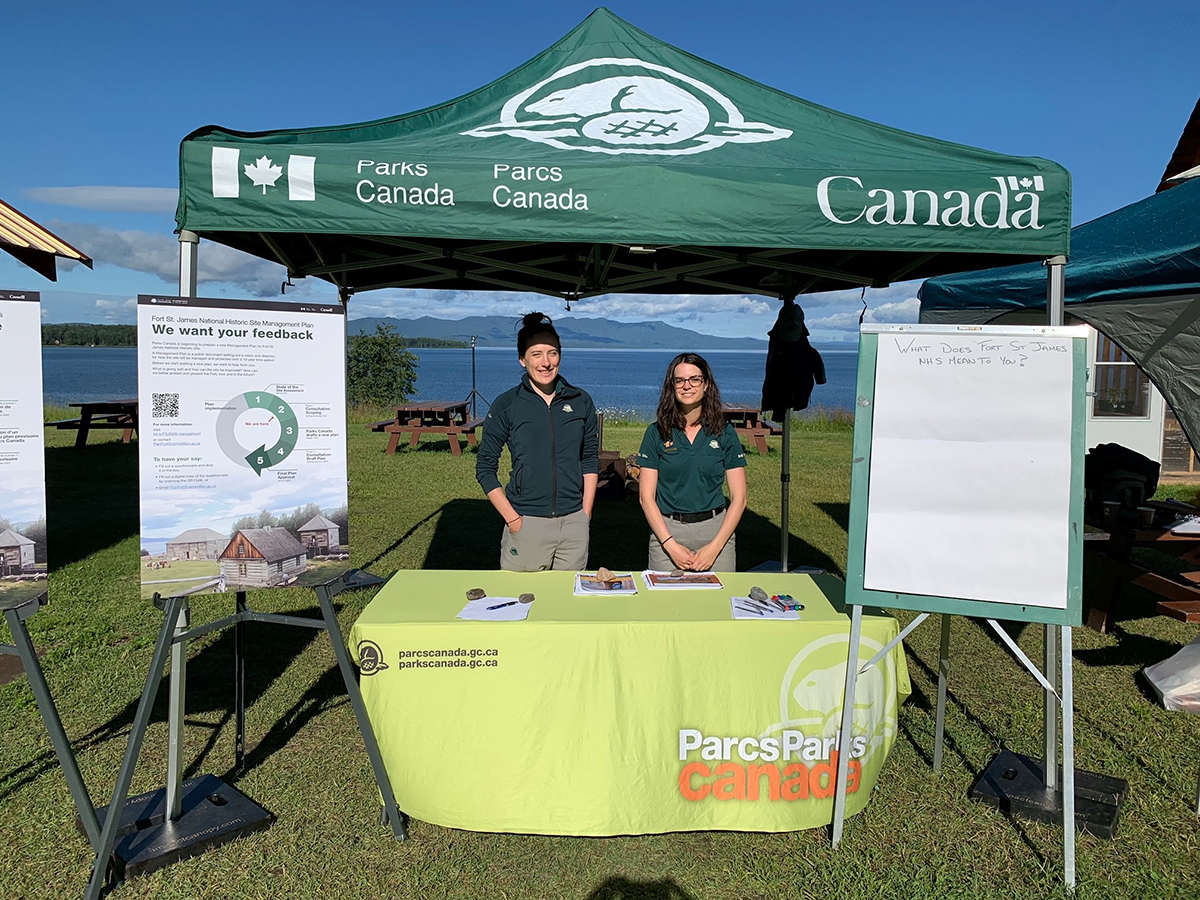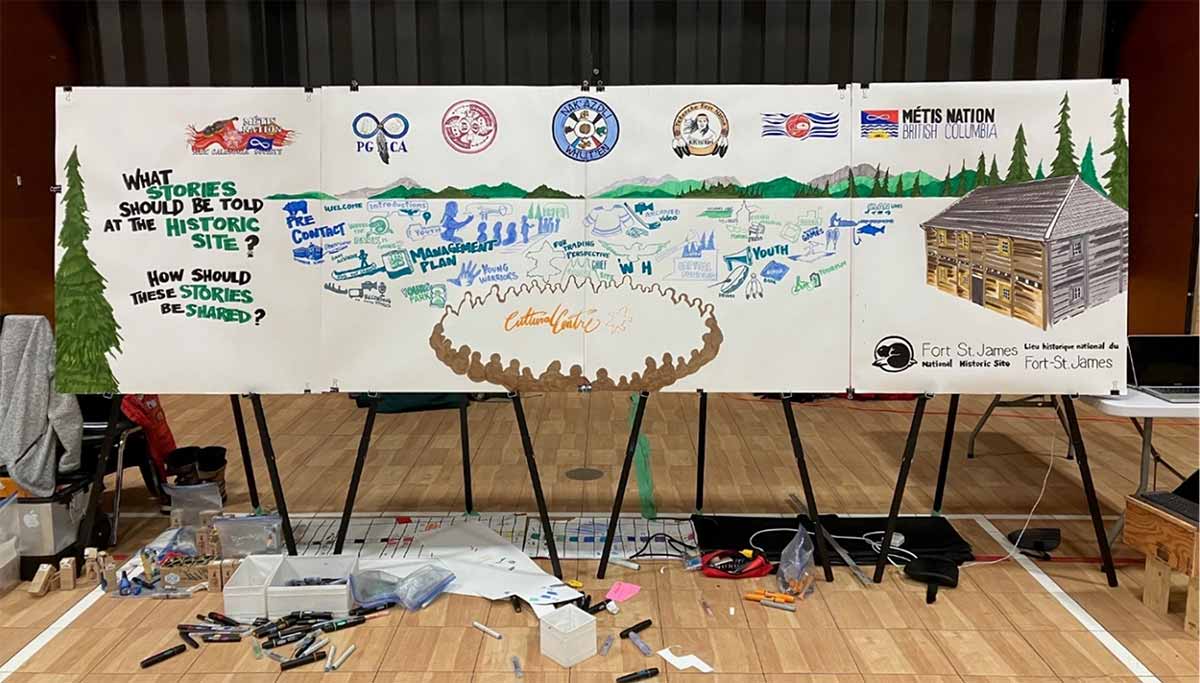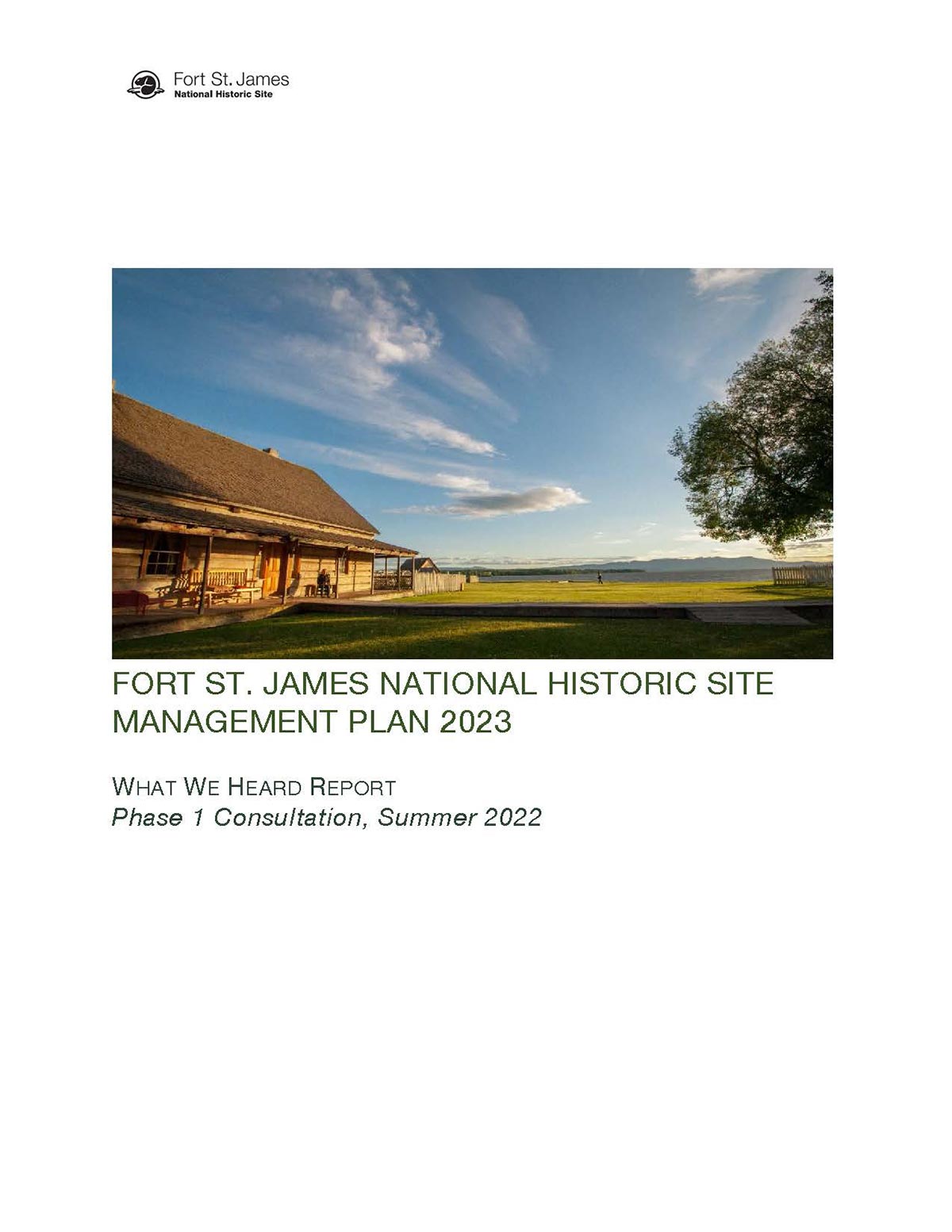What we heard report: Phase 1 consultation, summer 2022
Fort St. James National Historic Site
Introduction
In spring 2022 Parks Canada consulted with Indigenous partners, stakeholders, and the public to seek feedback on priorities for a new management plan for Fort St. James National Historic Site. This was the first of two phases of consultation – the second phase is planned for summer 2023. This ‘What We Heard Report’ summarizes the feedback Parks Canada heard during the first phase of consultation. The draft management plan will be finalized following a second phase of consultation in summer 2023.
Parks Canada sincerely thanks all those who shared their feedback, and we look forward to hearing from you again during the second phase of consultation.
Consultation overview

Photo: Alex Lader Alex Lader
Phase one of consultation for the new management plan for Fort St. James National Historic Site was open between May 5 and September 5, 2022. Objectives of this first phase of consultation were to inform Indigenous partners, stakeholders and the public about the management planning process and to seek feedback on important considerations to inform the development of the draft plan. An additional engagement with Indigenous partners was held in February 2023, to further discuss incorporating Indigenous stories on site.
Engagement by the numbers
- 62 respondents filled out the Parks Canada scoping survey
- 4 Indigenous partner communities met with Parks Canada
- 6 representatives from 4 stakeholder groups met with Parks Canada
- 24 Indigenous partner representatives participated in a multi-community workshop
Consultation activities
Parks Canada used a variety of consultation methods to maximize participation.
| Activity | Objectives |
|---|---|
| Indigenous | |
| Bilateral meetings | Three in-person bilateral meetings and one virtual bilateral meeting with Indigenous partners were held. Goals of the bilateral meetings were to:
|
| Multi-community workshop | First Nation and Métis partner groups met with Parks Canada to discuss what stories should be told on site and how these stories should be shared. A graphic recorder drew pictures representing ideas as they were shared. |
| Public and stakeholder | |
| Website | The Fort St. James National Historic Site website was used as a hub for providing project information and updates and included a link to the Phase 1 survey and project team contact information. |
| Social media | The site’s Twitter and Facebook pages were used to communicate the launch of consultation, key dates, and provided links to the project website. |
| Print advertising | Advertisements were placed in three newspapers with local and regional circulation to communicate the launch of consultation, key dates, and provide links to the project website. |
| Stakeholder meeting | One multilateral in-person meeting with local and regional stakeholders. |
| Online survey | A six-question survey was the primary mechanism for gathering feedback. The survey was available electronically via the project website, by hardcopy in the site’s visitor centre and at a pop-up booth at the annual Salmon Day event. |
| Information booth at Salmon Day | On July 13, 2022, at the site’s annual Salmon Day festival, Parks Canada set up an information booth to answer questions and collect public input on the draft management plan. |
Consultation with Indigenous partners
We heard the following themes from discussions with Indigenous partners:
Collaboration and involvement in site management
All partner groups felt there needs to be greater Indigenous collaboration and involvement in site management and operations at Fort St. James National Historic Site. Partners also expressed interest in exploring opportunities for a formalized mechanism to facilitate regular collaboration on site, like a multi-lateral advisory board.
The inclusion of both youth and elder perspectives emerged as an important aspect of collaboration. One partner indicated an existing youth council could be utilized as a starting point for greater inclusion of Indigenous youth voices.
Several partner groups expressed a sense of disconnection with the site. There is a desire to rebuild connections, feel represented and welcome.
Cultural representation and recognition
“Without us, this wouldn’t be here.” Partner groups felt there needs to be increased representation and recognition of the roles Indigenous peoples played, and continue to play, in shaping the site.
Partners see the site as an opportunity to raise cultural awareness and increase education. This could include increased interpretation by Indigenous peoples, cultural demonstrations, sharing of community artifacts and history, and partnering with communities to host special events related to Indigenous culture. Integrating Indigenous foods on the café menu was also suggested.
Several partners identified greater inclusion of the Dakelh language throughout the site (e.g., through updated signage) as an opportunity to raise awareness and increase a sense of welcoming.
One partner noted that the current location of the First Nations demonstration area could be perceived as a reflection of the relative importance of First Nations to the site. There is a desire for this area to be more prominent on site.
Another partner noted current highway signage advertising the site should better reflect Indigenous culture and site connections.
Marketing, promotion and visitation
Several partners thought the site could do a better job at marketing, including promoting special events, and partnering with communities and other organizations to advertise. Increasing visitation was generally seen as a positive goal, with positive spin-off benefits including increased revenue and opportunities to educate visitors on Indigenous culture.
One partner suggested lengthening the site’s operational season, considering events outside of the regular operating season (e.g., Christmas).
Site design, accessibility and maintenance
Partner groups noted that grounds accessibility can be difficult for elders and those with mobility challenges. These groups would like to see increased seating opportunities throughout the site and along the lake. Another partner identified several maintenance issues that should be addressed, including the tramway and waterfront trail. The waterfront area was also identified as an important community gathering area.
Multi-community workshop
In February of 2023, a multi-community workshop was held in Fort St. James with Indigenous partners. The purpose of the workshop was to understand what and how stories should be told at the site and strengthen relationships between Indigenous partners and Parks Canada. The discussion was supported by a graphic recorder who illustrated ideas as he heard them. (Note – see the completed graphic here.)
During the discussion, the following key points emerged:
- It is important to have permission to tell stories; Indigenous stories need to be told by Indigenous people;
- Stories can be told in a variety of ways; orally, through books, audio, and through art;
- There are a variety of stories that can be told; each Clan (Dakelh) has its own story;
- Respecting and promoting the legacy of Chief Kw’eh is important work;
- Ways to involve youth are important;
- Indigenous culture can be celebrated and promoted through special events and activities; and
- There are opportunities to work together with local communities to enhance tourism activities.

Photo: Alex Lader Alex Lader
Consultation with stakeholder groups
One multi-lateral stakeholder meeting was held, attended by the District of Fort St. James, Fort St. James Tourism Committee, BC Parks, and the Friends of Fort St. James. Stakeholders were asked to identify what they value most about the site, issues they feel should be addressed through the plan, and provide feedback on preliminary plan priorities.
We heard the following themes from the multi-stakeholder discussion:
Indigenous representation
Stakeholder groups highlighted the need for greater Indigenous cultural representation, greater Indigenous involvement, and to improve public awareness of Indigenous history and cultures. Indigenous histories and storytelling should be given the same emphasis as the non-Indigenous historical perspective. Strengthening relationships with Indigenous communities was identified as a site priority over the next ten years.
Visitor experience/ site programming
Several groups identified the variety of programming and visitor experiences on offer as a strength of the site, including special events (e.g. high tea, quilts in the park, Salmon day), in-person “living history” interpretation, school programming, and self-guided learning opportunities (e.g. audio tour, on-site museum); they also noted that the interpreters are an integral part of the Fort St. James visitor experience.
Exploring opportunities to increase programming variety and frequency, while maintaining an offer that is interactive, hands-on, authentic and accessible for all ages, was encouraged. One stakeholder suggested a need for more opportunities for children to play on site.
Visitation
Increasing site visitation, both by locals and travellers, was identified as a priority over the next ten years. The site was identified as being critical to the development of the local tourism industry.
Stakeholders identified site marketing and promotions as a barrier to increased visitation. They suggested site promotion could be improved through increased advertising, strategic partnerships with local and regional business and tourism agencies, and improved signage.
Stakeholder partnerships
Strategic partnerships with stakeholder groups (e.g., tourism operators) and Indigenous communities was noted as an opportunity to increase visitation and help promote tourism attractions in the surrounding area. Partnerships could be leveraged to assist with site operations and promotions.
Community hub
Stakeholders viewed the site as an integral part of the local community and suggested it should continue to be a community hub and gathering place.
Site grounds and infrastructure
The site grounds, including the garden and the beautiful vistas towards the lake, were identified as valued components of the site.
Building and asset maintenance was identified as a priority, including repairing the damaged tramway. Modernizing site infrastructure was noted as an opportunity.
Consultation with the general public
A six-question survey was the primary mechanism for gathering feedback from the public. The survey was available on the project website and by hardcopy in the site’s visitor centre and during the annual Salmon Day event. In total, 62 surveys were completed.
Survey questions were open-ended and aimed to understand current site values, priorities, and opportunities to focus on over the next 10 years. 78% of survey respondents were from British Columbia, with residents of Fort St. James, Vanderhoof and Prince George comprising 54% of total respondents. 13% of respondents were from Alberta, 5% from Ontario, and 1 international response was received.
We heard the following themes in response to the question “What key words or phrases would you use to describe the site?”
- historic
- educational/informative
- beautiful/scenic
- well-maintained/preserved
- community-hub
- authentic
- interactive
- hands-on
- lacking Indigenous representation
- colonial/Eurocentric
We heard the following themes in response to the question “What do you value the most about Fort St. James National Historic Site?”
- site grounds
- views and location
- special events
- educational opportunities and school programs
- costumed interpreters
- interactive learning
- preservation of the buildings
- opportunities for education about settler/Indigenous history and reconciliation
The Fort St. James National Historic Site State of the Site Assessment, completed in 2022, identified three key issues: strengthening Indigenous relations; maintaining and renewing existing site buildings and infrastructure, and stabilizing visitation. Most respondents were in agreement with these priorities. Several respondents noted that strengthening Indigenous relations should take precedence over the other two priorities. Another respondent noted that visitation should be increased, rather than stabilized.
For the remaining survey questions, respondents provided open-ended feedback on issues, opportunities, and priorities for the site. Themes we heard included:
Indigenous relations
Many respondents mentioned the need for stronger relationships with Indigenous communities, and better representation of Indigenous culture and perspectives at the site. Suggestions included involving elders to help tell cultural stories, increasing opportunities for Dakelh cultural demonstrations, collaborating with communities on site management and operations, reviewing the content of the museum, and hosting special events. Respondents noted a need for Indigenous staff and opportunities for staff training on local Indigenous culture.
Infrastructure
Respondents identified several opportunities for improvement of site infrastructure. These included: general maintenance, a new visitors centre, parking lot improvements, pathway maintenance and accessibility, and rebuilding the tramway.
Marketing and promotions
Several respondents felt that site marketing, advertising and promotions could be improved to increase visitation. Ideas included a greater social media presence, television advertising, having site staff attend external events, and partnering with other organizations for promotions.
Community involvement
The importance of facilitating greater community involvement and partnership emerged as a theme. The site is viewed as a community hub and could be better utilized for community events. Some examples of opportunities for community partnership included working with the 4H club for caring for animals and community gardening.
Visitor experience
Many survey respondents provided feedback on the site’s visitor experience offer. In general, there is satisfaction with the types of activities and experiences provided, however there is a desire for more. Some respondents indicated a desire for a wider variety of activities, such as water-based experiences (e.g., canoeing or fishing on the lake). Others suggested more historical demonstrations, hands-on activities, and more interpretive signage for a self-guided experience.
Operations
Feedback related to site operations suggested the site increase their operating season and hours, hire more interpreters, investigate additional revenue-generating opportunities, expand the café menu, and streamline booking processes for school groups.
Other respondents highlighted difficulties in attracting staff, suggesting a need for staff accommodations.
Next steps
Parks Canada has considered all feed-back heard during phase 1 of consultation and has developed a draft management plan for Fort St. James National Historic Site. Once finalised, this will replace the current 2013 management plan for the site.
Phase 2 consultation will launch in Summer 2023 and engage Indigenous partners, stakeholder groups, and the general public to seek feedback on the draft management plan.
Contacts us
If you have any questions on consultation on the Fort St. James management plan, please contact Parks Canada at PlanFortStJames@pc.gc.ca.

Text version
A graphic recording visually depicts the discussion during an Indigenous multi-partner workshop in February, 2023. Two key questions are illustrated; What stories should be told at the historic site? How should these stories be shared? Illustrated discussion points include: Indigenous stories need to be told by Indigenous people, respecting and promoting the legacy of Chief K'wah, youth involvement, celebrating Indigenous culture, working together to enhance tourism activities. Indigenous partner Nations are represented by their logos and include Métis Nation New Caledonia Society, Prince George Metis Community Association (PG MCA), Tl’azten Nation, Nak’azdli Whut’en, Yekooche First Nation, Binche Whut’en, and Métis Nation British Columbia.
- Date modified :
